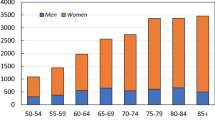Abstract
Introduction
Hip fractures account for a growing number of hospital admissions worldwide and are associated with significant morbidity and mortality. The Nottingham Hip Fracture Score (NHFS) was developed to help risk-stratify these patients. Frailty is increasingly recognised to be a predictor of adverse outcomes. The aim of this study, using prospectively collected data from two non-specialist UK hospitals, was to report contemporaneous outcomes for patients with a hip fracture and compare the performance of the NHFS with the Clinical Frailty Scale (CFS).
Materials and methods
Data were collected over a 3-year period (2016–2018) from patients admitted with a hip fracture. In-patient and 1-year mortality and length of stay were compared between the NHFS, CFS and other variables. For discrimination to predict mortality, area under the receiver operating characteristic (AUC) curves were produced.
Results
2422 patients (70.6% female), median age 85 (interquartile range 78–90) were included, with 93% undergoing an operation. 30-day mortality was 5.8% and 1-year mortality 23.5%. Average hospital stay was 18.0 days (Standard deviation 13.7). For in-patient mortality AUC for NHFS was 0.69 (95% CI 0.64–0.74) and for CFS 0.63 (0.57–0.69); for 1-year mortality AUC for NHFS was 0.71 (0.68–0.73) and for CFS 0.67 (0.64–0.71). Neither score predicted extended hospital stay.
Conclusion
Both CFS and NHFS predict 1-year survival with similar, moderate discrimination. Future research could explore whether other factors could be combined to allow better risk stratification following a hip fracture to inform patients and clinicians.



Similar content being viewed by others
References
Royal College of Physicians (2019) National hip fracture database annual report 2019. RCP, London. Accessed 18 Aug 2020
Royal College of Physicians (2010) National hip fracture database national report 2010. RCP, London. Accessed 18 Aug 2020
Maxwell MJ, Moran CG, Moppett IK (2008) Development and validation of a preoperative scoring system to predict 30 day mortality in patients undergoing hip fracture surgery. Br J Anaesth 101:511–517
Puts MTE, Toubasi S, Andrew MK, Ashe MC, Ploeg J, Atkinson E, Ayala AP, Roy A, Rodríguez Monforte M, Bergman H, McGilton K (2017) Interventions to prevent or reduce the level of frailty in community-dwelling older adults: a scoping review of the literature and international policies. Age Ageing 46:383–392
British Medical Association. Focus on identification and management of patients with frailty. https://www.bma.org.uk/advice/employment/contracts/general-practice-funding/focus-on-identification-and-management-of-patients-with-frailty. Accessed 18 Mar 2020
Rockwood K, Song X, MacKnight C, Bergman H, Hogan DB, McDowell I, Mitnitski A (2005) A global clinical measure of fitness and frailty in elderly people. CMAJ 173:489–495
Moppett IK, Parker M, Griffiths R, Bowers T, White SM, Morgan CG (2012) Nottingham Hip Fracture Score: longitudinal and multi-centre assessment. Br J Anaesth 109:546–550
Steyerberg EW, Vickers AJ, Cook NR, Gerds T, Gonen M, Obuchowski N, Pencina MJ, Kattan MW (2010) Assessing the performance of prediction models: a framework for traditional and novel measures. Epidemiology 21:128–138
Wiles MD, Moran CG, Sahota O, Moppett IK (2011) Nottingham Hip Fracture Score as a predictor of one year mortality in patients undergoing surgical repair of fractured neck of femur. Br J Anaesth 106:501–504
de Jong L, Mal Klem T, Kuijper TM, Roukema GR (2019) Validation of the Nottingham Hip Fracture Score (NHFS) to predict 30-day mortality in patients with an intracapsular hip fracture. Orthop Traumatol Surg Res 105:485–489
Lisk R, Yeong K, Fluck D, Fry CH, Han TS (2020) The ability of the Nottingham Hip Fracture Score to predict mobility, length of stay and mortality in hospital, and discharge destination in patients admitted with a hip fracture. Calcif Tissue Int 107:319–326
Doherty WJ, Stubbs TA, Chaplin A, Reed MR, Sayer AA, Witham MD, Sorial AK (2020) Prediction of postoperative outcomes following hip fracture surgery: independent validation and recalibration of the Nottingham Hip Fracture Score. J Am Med Dir Assoc. https://doi.org/10.1016/j.jamda.2020.07.013
Marufu TC, Mannings A, Moppett IK (2015) Risk scoring models for predicting peri-operative morbidity and mortality in people with fragility hip fractures: qualitative systematic review. Injury 46:2325–2334
Karres J, Heesakkers NA, Ultee JM, Vrouenraets BC (2015) Predicting 30-day mortality following hip fracture surgery: evaluation of six risk prediction models. Injury 46:371–377
Menéndez-Colino R, Gutiérrez Misis A, Alarcon T, Díez-Sebastián J, Díaz de Bustamante M, Queipo R, Otero A, González-Montalvo JI (2020) Development of a new comprehensive preoperative risk score for predicting 1-year mortality in patients with hip fracture: the HULP-HF score. Comparison with 3 other risk prediction models. Hip Int. https://doi.org/10.1177/1120700020947954
Klop C, Welsing PM, Cooper C, Harvey NC, Elders PJ, Bijlsma JW, Leufkens HG, de Vries F (2014) Mortality in British hip fracture patients, 2000–2010: a population-based retrospective cohort study. Bone 66:171–177
Simunovic N, Devereaux PJ, Sprague S, Guyatt GH, Schemitsch E, Debeer J, Bhandari M (2010) Effect of early surgery after hip fracture on mortality and complications: systematic review and meta-analysis. CMAJ 182:1609–1616
Moppett IK, Wiles MD, Moran CG, Sahota O (2012) The Nottingham Hip Fracture Score as a predictor of early discharge following fractured neck of femur. Age Ageing 41:322–326
Krishnan M, Beck S, Havelock W, Eeles E, Hubbard RE, Johansen A (2014) Predicting outcome after hip fracture: using a frailty index to integrate comprehensive geriatric assessment results. Age Ageing 43:122–126
Author information
Authors and Affiliations
Corresponding author
Ethics declarations
Conflict of interest
All authors have no conflicts of interest.
Ethical approval
Ethical approval was given by NHS South Central – Hampshire B Research Ethics Committee (REC reference 18/SC/0513).
Informed consent
No informed consent was gained for this retrospective study of anonymised routinely collected data.
Additional information
Publisher's Note
Springer Nature remains neutral with regard to jurisdictional claims in published maps and institutional affiliations.
About this article
Cite this article
Thorne, G., Hodgson, L. Performance of the Nottingham Hip Fracture Score and Clinical Frailty Scale as predictors of short and long-term outcomes: a dual-centre 3-year observational study of hip fracture patients. J Bone Miner Metab 39, 494–500 (2021). https://doi.org/10.1007/s00774-020-01187-x
Received:
Accepted:
Published:
Issue Date:
DOI: https://doi.org/10.1007/s00774-020-01187-x




